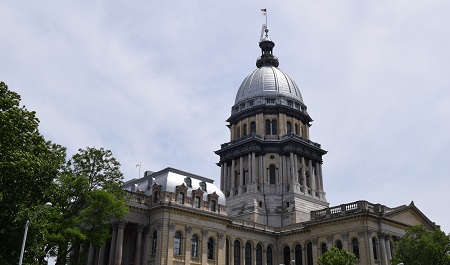Recently, the Governor issued an amendatory veto of the school funding trailer bill, which begs the question: what happens next so schools can finally start getting their new funding? But before we answer that, we’ll walk through a few other questions for background:
- What was the funding bill?
- What does “trailer bill” mean?
- What is the amendatory veto (AV)?
What was the funding bill? SB1947 was a long overdue overhaul of Illinois’s worst-in-the-nation school funding formula, supported on a broad bipartisan basis and signed into law by Governor Rauner. There were basically four steps in the new formula:
- First, every district would get the same amount of state funding it received last year. That’s called its Base Funding Minimum.
- Then, a Local Capacity Target is calculated to show how much local revenue a school district can collect through property taxes. When we add the Base Funding Minimum and the Local Capacity Target, we can see how much funding the district already has available to spend.
- Next, a unique Adequacy Target is determined, based on the actual costs of providing best practices to educate the student population in that district.
- Finally, as the state allocates new funds to education, it distributes the new funds in tiers, with the school districts whose Local Capacity Targets are furthest from their Adequacy Targets getting the most. This year, Springfield allocated $350 million in new dollars to education, a significant amount but not nearly enough to get all districts to Adequacy.
SB1947 also included the Invest in Kids Act, a program that would give tax breaks to donors who contributed to a scholarship fund for low-income students attending state-recognized, private schools.
Check out our blog post all about the funding formula here and read more about the tax-credit scholarships here. Even though the Governor has been touting this bill as the top accomplishment of his tenure and a key reason to re-elect him, last week he issued an AV that would delay the neediest schools getting the increased investment they so desperately need. Confused on why he thought doing so was a good idea? Me too.
What does “trailer bill” mean?
Almost any time the legislature passes a huge bill, there are some technical odds and ends that need to be tied up. A “trailer bill” comes after the major substantive legislation. SB1947 was one of the biggest changes in years, and as the State Board of Education (ISBE) began their gargantuan task of implementing the new formula, the agency found a couple of critical changes that had to be tweaked before releasing the new money. ISBE asked the legislature for a trailer bill to make those changes, and SB444 passed on a bipartisan basis, giving ISBE the changes it requested. The House unanimously voted for the trailer bill, and the Senate voted 42-11 for it.
Specifically, the technical changes in SB444 fixed two drafting errors, both of which assumed that districts had access to more property wealth than they actually have. (This is important during that second step: calculating the Local Capacity Target.) Some of those districts couldn’t access the local revenue for a variety of reasons, but regardless, the result is that 178 school districts would unfairly appear to be more adequately funded than they actually are.
There are likely dozens of other technical changes to discuss and clean-up in another trailer bill in the longer term. But these fixes in SB444 are the most critical two to ensure that the funds go where they were intended.
What is the amendatory veto?
Instead of signing the bill into law, the Governor issued an amendatory veto adding another change that has to do with the difference between being a state-recognized school, or merely a state-registered school. Right now, only state-recognized, private schools can participate in the Invest in Kids program Some might say that before tax dollars go to private schools, the schools should at least cross a minimum threshold. Recognition requires site visits, curriculum reviews, staff background checks, anti-discrimination policies, and other ISBE oversight. After all, public school performance is transparent because of the state’s school report cards; there is no private-school equivalent.
The amendatory veto would expand participation in the tax credit scholarship program to schools that are state-registered by February 2018; effectively 250 private schools that are “registered,” but not “recognized,” would automatically be eligible.
Some private schools say they have never pursued recognition because there was no reason to, but now they are scrambling to go through the recognition process so they can accept scholarships.
What happens next before schools can get their funding?
ISBE has a challenge ahead of it to implement the new funding model for the first time, and the language confusion adds to an already-tough job. The Senate comes back to session on January 30, so that is the soonest SB444 could see legislative action. At that point, there are three options, and it is generally up to the chief sponsor to decide which one to pursue (with one big caveat*):
- They can override the AV, which requires a three-fifths majority vote. Then the language of SB444 before the AV would take effect, and tax-credit scholarships would only go to state-recognized private schools.
- They can accept the AV, which requires a simple majority vote. Then the language of SB444 would take effect, including the Governor’s recommended change expanding participating private schools.
- Or, they can do nothing, which would leave 178 school districts with inaccurate local wealth assumptions and cause even more confusion about implementation.
When reasonable people have a desire to compromise and meet each other halfway, they can sometimes negotiate an agreement to address the issues in an AV through another bill. The question is whether leaders in Springfield are feeling amenable to compromise these days. The school year is almost halfway over. We’ve all celebrated passage of this historic bill, which indeed deserves celebration – but our students still haven’t seen a penny of new money through the formula. It is time to stop the administrative delays, give ISBE what it needs to do its job, and get our schools the new investment we promised.
*About that caveat, it is up to the Rules Committee or Assignments Committee to assign the chief sponsor’s motion. (Literally, the chief sponsor will sign a piece of paper that says they move to accept the Governor’s changes or override them. That “motion” is filed and comes before these procedural committees that assign legislation to their next destination, like a substantive committee or to the floor.) If an amendatory veto is deemed “non-compliant,” the Rules Committee won’t move forward a motion to accept the changes. Amendatory vetoes that exceed the scope of the original bill are deemed “non-compliant.”





